MGT602: Reflective Report on Influencing and Decision Making Process
VerifiedAdded on 2022/08/22
|6
|1328
|22
Report
AI Summary
This report delves into the author's decision-making processes, focusing on two recent decisions: starting extracurricular activities and enrolling in a data analytics course. The author, identifying as an INJL personality type, prioritizes analysis over emotional responses and employs the Quasirationality model due to limited information. The report outlines the data collection and analysis used to evaluate alternatives, highlighting the benefits of extracurricular activities, such as enriching students' lives and fostering creativity, while acknowledging the potential advantages of part-time employment. The author ultimately chose extracurricular activities, considering workload and potential study impacts. The report references key concepts like bounded rationality and provides a detailed reflection on the decision-making journey.
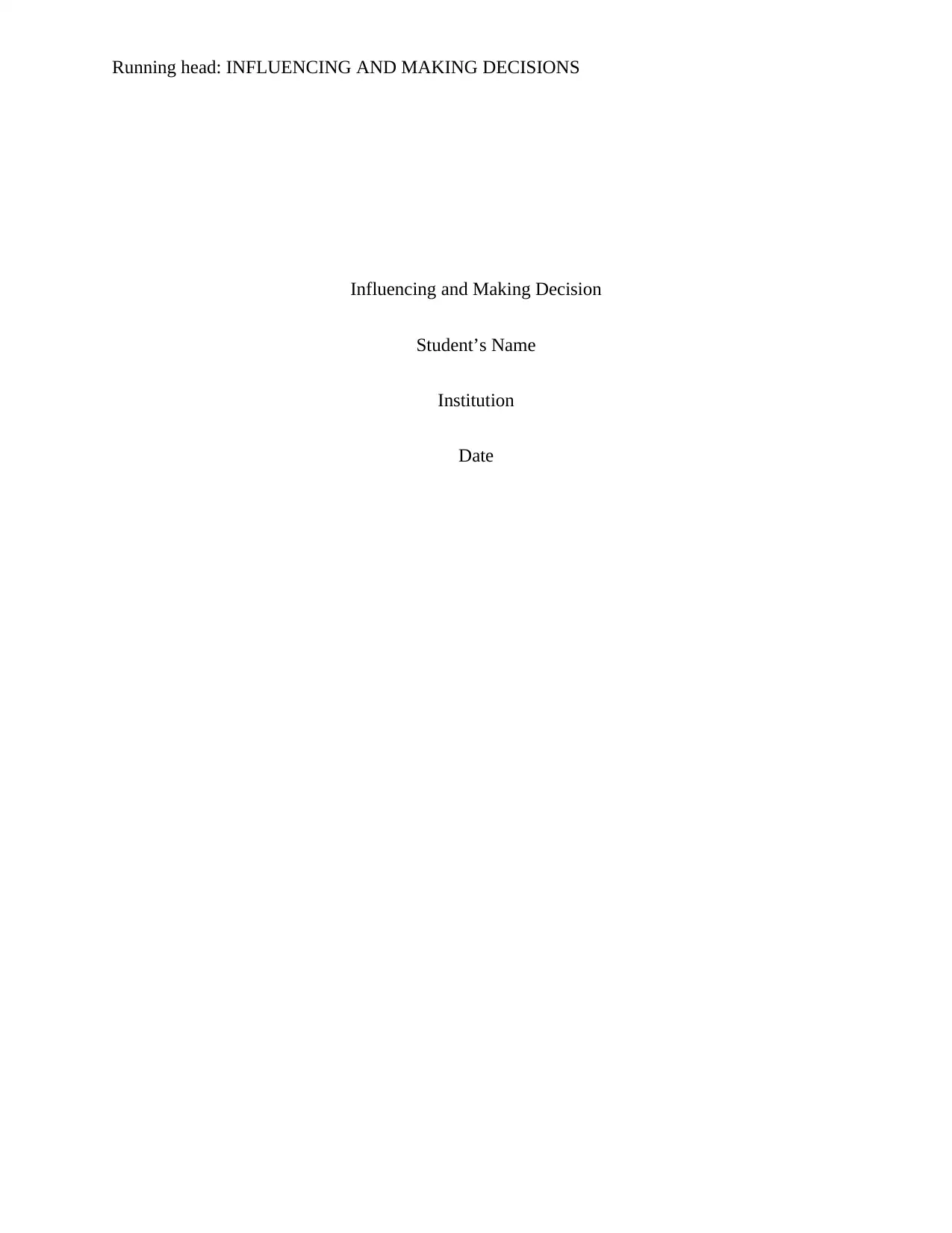
Running head: INFLUENCING AND MAKING DECISIONS
Influencing and Making Decision
Student’s Name
Institution
Date
Influencing and Making Decision
Student’s Name
Institution
Date
Paraphrase This Document
Need a fresh take? Get an instant paraphrase of this document with our AI Paraphraser
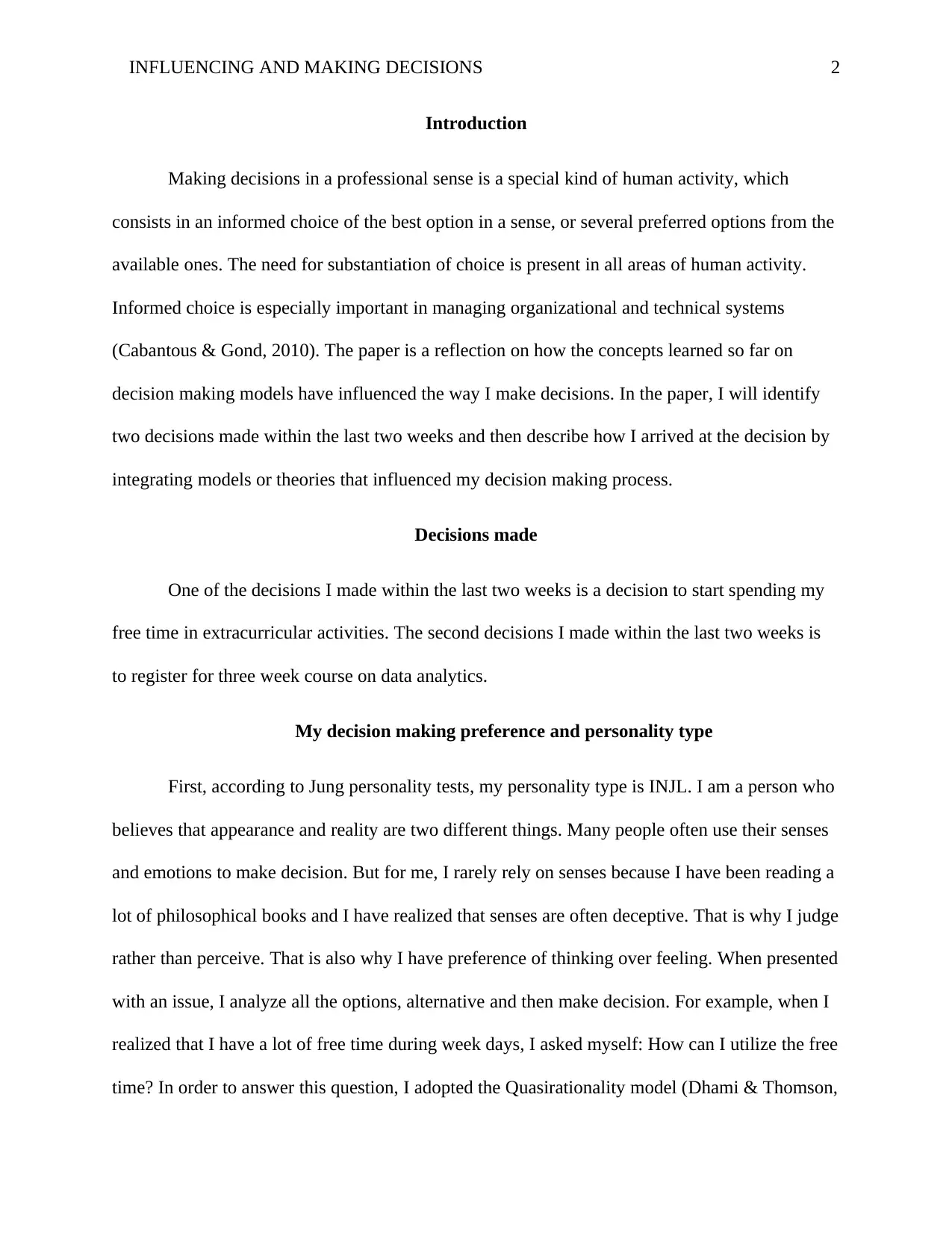
INFLUENCING AND MAKING DECISIONS 2
Introduction
Making decisions in a professional sense is a special kind of human activity, which
consists in an informed choice of the best option in a sense, or several preferred options from the
available ones. The need for substantiation of choice is present in all areas of human activity.
Informed choice is especially important in managing organizational and technical systems
(Cabantous & Gond, 2010). The paper is a reflection on how the concepts learned so far on
decision making models have influenced the way I make decisions. In the paper, I will identify
two decisions made within the last two weeks and then describe how I arrived at the decision by
integrating models or theories that influenced my decision making process.
Decisions made
One of the decisions I made within the last two weeks is a decision to start spending my
free time in extracurricular activities. The second decisions I made within the last two weeks is
to register for three week course on data analytics.
My decision making preference and personality type
First, according to Jung personality tests, my personality type is INJL. I am a person who
believes that appearance and reality are two different things. Many people often use their senses
and emotions to make decision. But for me, I rarely rely on senses because I have been reading a
lot of philosophical books and I have realized that senses are often deceptive. That is why I judge
rather than perceive. That is also why I have preference of thinking over feeling. When presented
with an issue, I analyze all the options, alternative and then make decision. For example, when I
realized that I have a lot of free time during week days, I asked myself: How can I utilize the free
time? In order to answer this question, I adopted the Quasirationality model (Dhami & Thomson,
Introduction
Making decisions in a professional sense is a special kind of human activity, which
consists in an informed choice of the best option in a sense, or several preferred options from the
available ones. The need for substantiation of choice is present in all areas of human activity.
Informed choice is especially important in managing organizational and technical systems
(Cabantous & Gond, 2010). The paper is a reflection on how the concepts learned so far on
decision making models have influenced the way I make decisions. In the paper, I will identify
two decisions made within the last two weeks and then describe how I arrived at the decision by
integrating models or theories that influenced my decision making process.
Decisions made
One of the decisions I made within the last two weeks is a decision to start spending my
free time in extracurricular activities. The second decisions I made within the last two weeks is
to register for three week course on data analytics.
My decision making preference and personality type
First, according to Jung personality tests, my personality type is INJL. I am a person who
believes that appearance and reality are two different things. Many people often use their senses
and emotions to make decision. But for me, I rarely rely on senses because I have been reading a
lot of philosophical books and I have realized that senses are often deceptive. That is why I judge
rather than perceive. That is also why I have preference of thinking over feeling. When presented
with an issue, I analyze all the options, alternative and then make decision. For example, when I
realized that I have a lot of free time during week days, I asked myself: How can I utilize the free
time? In order to answer this question, I adopted the Quasirationality model (Dhami & Thomson,
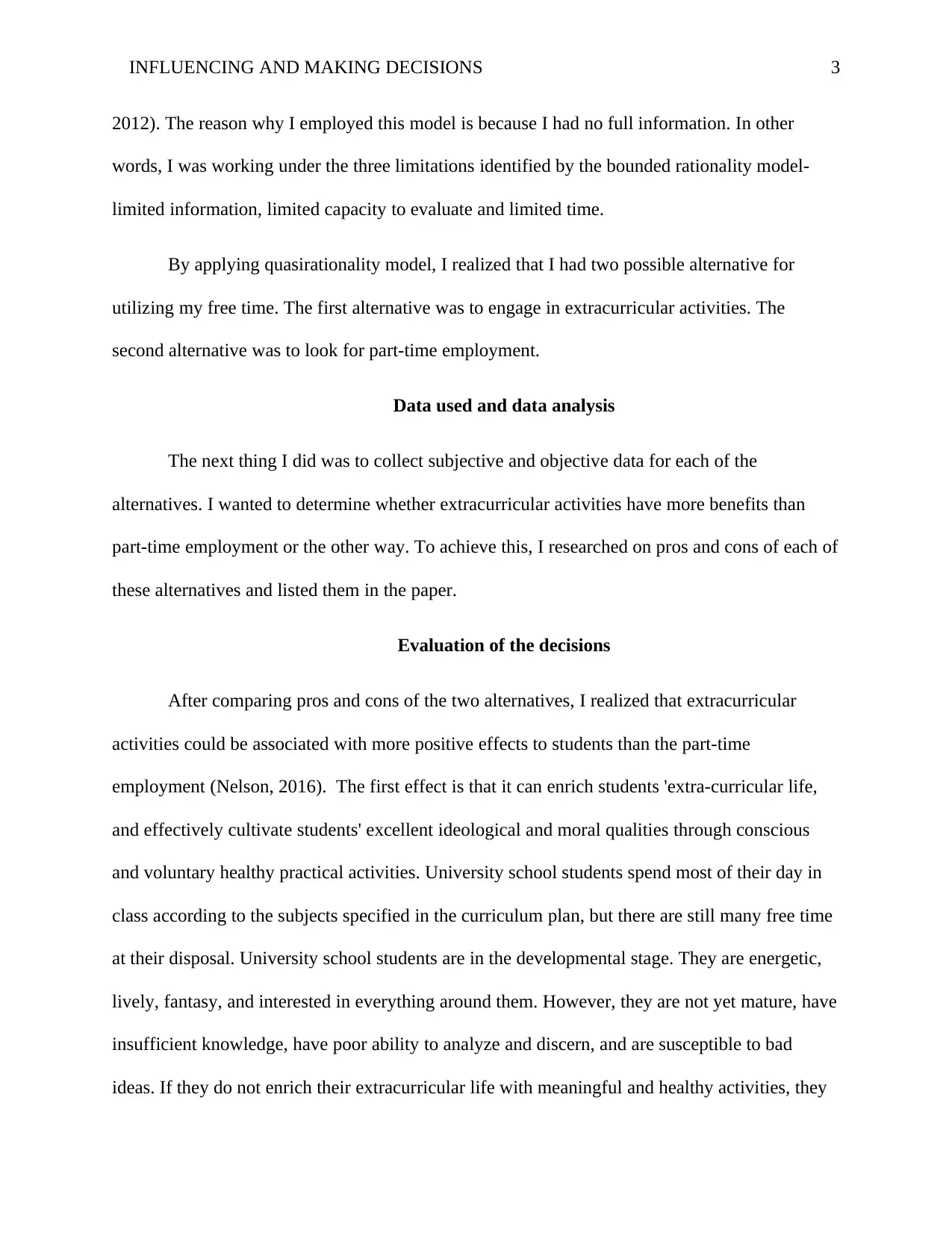
INFLUENCING AND MAKING DECISIONS 3
2012). The reason why I employed this model is because I had no full information. In other
words, I was working under the three limitations identified by the bounded rationality model-
limited information, limited capacity to evaluate and limited time.
By applying quasirationality model, I realized that I had two possible alternative for
utilizing my free time. The first alternative was to engage in extracurricular activities. The
second alternative was to look for part-time employment.
Data used and data analysis
The next thing I did was to collect subjective and objective data for each of the
alternatives. I wanted to determine whether extracurricular activities have more benefits than
part-time employment or the other way. To achieve this, I researched on pros and cons of each of
these alternatives and listed them in the paper.
Evaluation of the decisions
After comparing pros and cons of the two alternatives, I realized that extracurricular
activities could be associated with more positive effects to students than the part-time
employment (Nelson, 2016). The first effect is that it can enrich students 'extra-curricular life,
and effectively cultivate students' excellent ideological and moral qualities through conscious
and voluntary healthy practical activities. University school students spend most of their day in
class according to the subjects specified in the curriculum plan, but there are still many free time
at their disposal. University school students are in the developmental stage. They are energetic,
lively, fantasy, and interested in everything around them. However, they are not yet mature, have
insufficient knowledge, have poor ability to analyze and discern, and are susceptible to bad
ideas. If they do not enrich their extracurricular life with meaningful and healthy activities, they
2012). The reason why I employed this model is because I had no full information. In other
words, I was working under the three limitations identified by the bounded rationality model-
limited information, limited capacity to evaluate and limited time.
By applying quasirationality model, I realized that I had two possible alternative for
utilizing my free time. The first alternative was to engage in extracurricular activities. The
second alternative was to look for part-time employment.
Data used and data analysis
The next thing I did was to collect subjective and objective data for each of the
alternatives. I wanted to determine whether extracurricular activities have more benefits than
part-time employment or the other way. To achieve this, I researched on pros and cons of each of
these alternatives and listed them in the paper.
Evaluation of the decisions
After comparing pros and cons of the two alternatives, I realized that extracurricular
activities could be associated with more positive effects to students than the part-time
employment (Nelson, 2016). The first effect is that it can enrich students 'extra-curricular life,
and effectively cultivate students' excellent ideological and moral qualities through conscious
and voluntary healthy practical activities. University school students spend most of their day in
class according to the subjects specified in the curriculum plan, but there are still many free time
at their disposal. University school students are in the developmental stage. They are energetic,
lively, fantasy, and interested in everything around them. However, they are not yet mature, have
insufficient knowledge, have poor ability to analyze and discern, and are susceptible to bad
ideas. If they do not enrich their extracurricular life with meaningful and healthy activities, they
⊘ This is a preview!⊘
Do you want full access?
Subscribe today to unlock all pages.

Trusted by 1+ million students worldwide
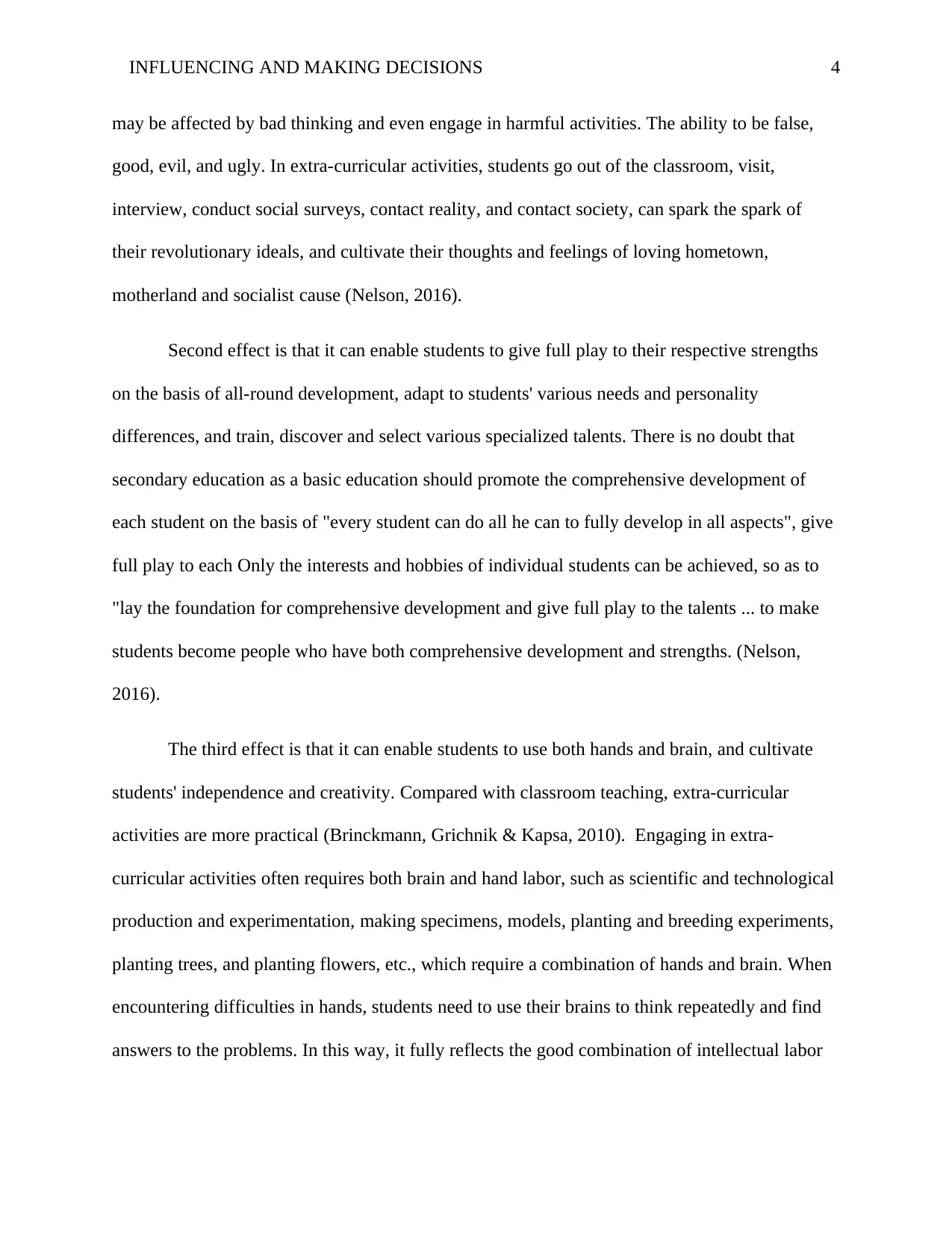
INFLUENCING AND MAKING DECISIONS 4
may be affected by bad thinking and even engage in harmful activities. The ability to be false,
good, evil, and ugly. In extra-curricular activities, students go out of the classroom, visit,
interview, conduct social surveys, contact reality, and contact society, can spark the spark of
their revolutionary ideals, and cultivate their thoughts and feelings of loving hometown,
motherland and socialist cause (Nelson, 2016).
Second effect is that it can enable students to give full play to their respective strengths
on the basis of all-round development, adapt to students' various needs and personality
differences, and train, discover and select various specialized talents. There is no doubt that
secondary education as a basic education should promote the comprehensive development of
each student on the basis of "every student can do all he can to fully develop in all aspects", give
full play to each Only the interests and hobbies of individual students can be achieved, so as to
"lay the foundation for comprehensive development and give full play to the talents ... to make
students become people who have both comprehensive development and strengths. (Nelson,
2016).
The third effect is that it can enable students to use both hands and brain, and cultivate
students' independence and creativity. Compared with classroom teaching, extra-curricular
activities are more practical (Brinckmann, Grichnik & Kapsa, 2010). Engaging in extra-
curricular activities often requires both brain and hand labor, such as scientific and technological
production and experimentation, making specimens, models, planting and breeding experiments,
planting trees, and planting flowers, etc., which require a combination of hands and brain. When
encountering difficulties in hands, students need to use their brains to think repeatedly and find
answers to the problems. In this way, it fully reflects the good combination of intellectual labor
may be affected by bad thinking and even engage in harmful activities. The ability to be false,
good, evil, and ugly. In extra-curricular activities, students go out of the classroom, visit,
interview, conduct social surveys, contact reality, and contact society, can spark the spark of
their revolutionary ideals, and cultivate their thoughts and feelings of loving hometown,
motherland and socialist cause (Nelson, 2016).
Second effect is that it can enable students to give full play to their respective strengths
on the basis of all-round development, adapt to students' various needs and personality
differences, and train, discover and select various specialized talents. There is no doubt that
secondary education as a basic education should promote the comprehensive development of
each student on the basis of "every student can do all he can to fully develop in all aspects", give
full play to each Only the interests and hobbies of individual students can be achieved, so as to
"lay the foundation for comprehensive development and give full play to the talents ... to make
students become people who have both comprehensive development and strengths. (Nelson,
2016).
The third effect is that it can enable students to use both hands and brain, and cultivate
students' independence and creativity. Compared with classroom teaching, extra-curricular
activities are more practical (Brinckmann, Grichnik & Kapsa, 2010). Engaging in extra-
curricular activities often requires both brain and hand labor, such as scientific and technological
production and experimentation, making specimens, models, planting and breeding experiments,
planting trees, and planting flowers, etc., which require a combination of hands and brain. When
encountering difficulties in hands, students need to use their brains to think repeatedly and find
answers to the problems. In this way, it fully reflects the good combination of intellectual labor
Paraphrase This Document
Need a fresh take? Get an instant paraphrase of this document with our AI Paraphraser
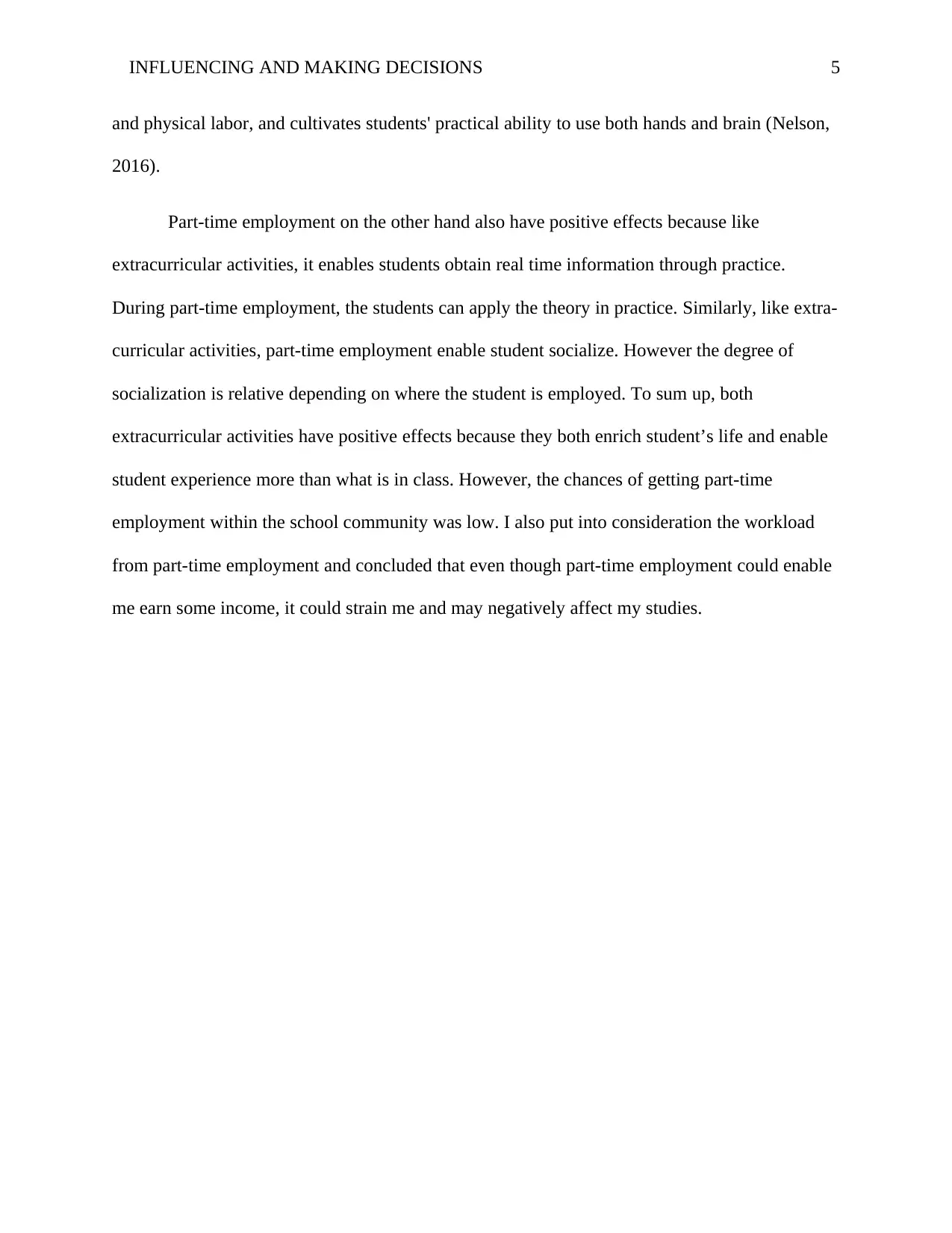
INFLUENCING AND MAKING DECISIONS 5
and physical labor, and cultivates students' practical ability to use both hands and brain (Nelson,
2016).
Part-time employment on the other hand also have positive effects because like
extracurricular activities, it enables students obtain real time information through practice.
During part-time employment, the students can apply the theory in practice. Similarly, like extra-
curricular activities, part-time employment enable student socialize. However the degree of
socialization is relative depending on where the student is employed. To sum up, both
extracurricular activities have positive effects because they both enrich student’s life and enable
student experience more than what is in class. However, the chances of getting part-time
employment within the school community was low. I also put into consideration the workload
from part-time employment and concluded that even though part-time employment could enable
me earn some income, it could strain me and may negatively affect my studies.
and physical labor, and cultivates students' practical ability to use both hands and brain (Nelson,
2016).
Part-time employment on the other hand also have positive effects because like
extracurricular activities, it enables students obtain real time information through practice.
During part-time employment, the students can apply the theory in practice. Similarly, like extra-
curricular activities, part-time employment enable student socialize. However the degree of
socialization is relative depending on where the student is employed. To sum up, both
extracurricular activities have positive effects because they both enrich student’s life and enable
student experience more than what is in class. However, the chances of getting part-time
employment within the school community was low. I also put into consideration the workload
from part-time employment and concluded that even though part-time employment could enable
me earn some income, it could strain me and may negatively affect my studies.
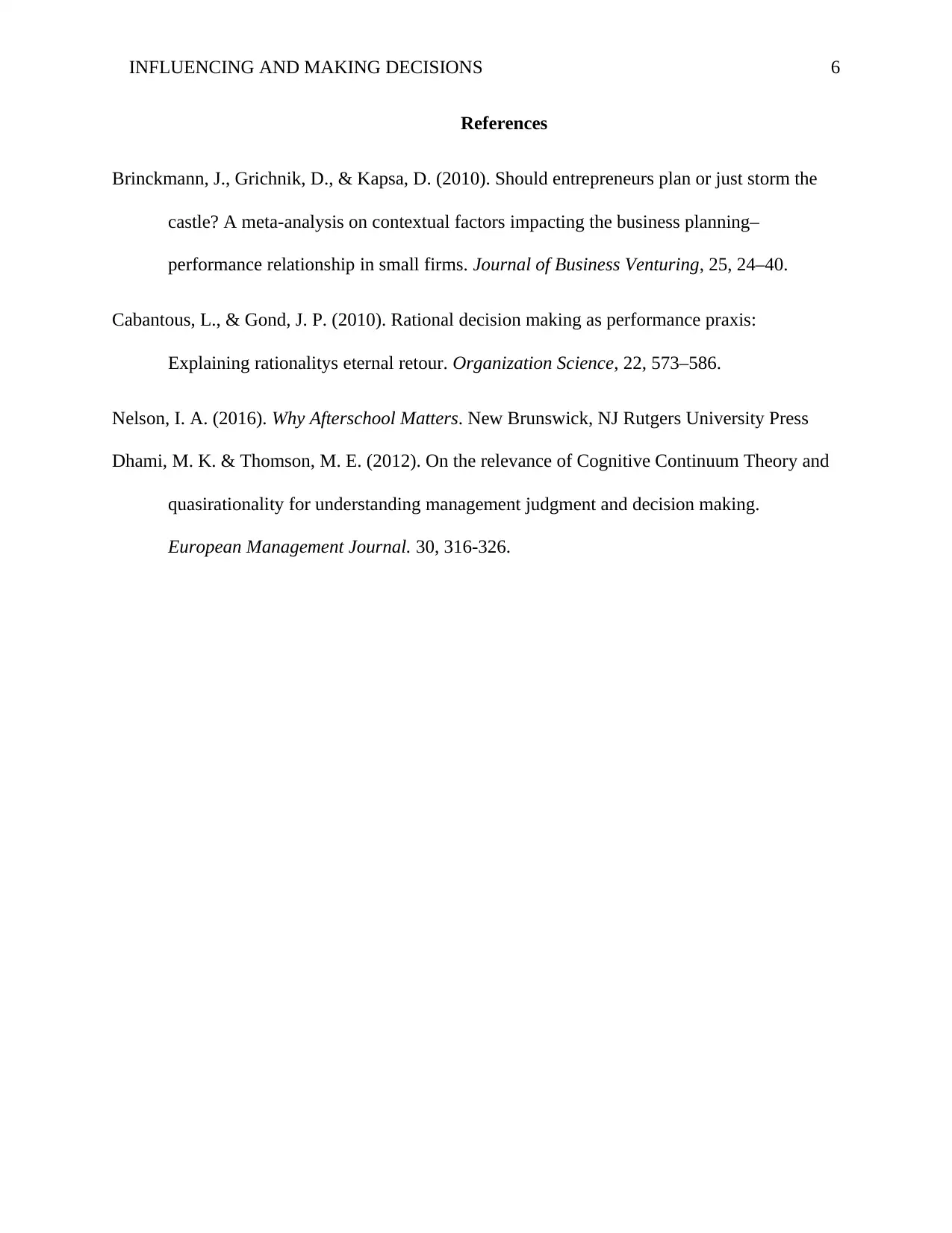
INFLUENCING AND MAKING DECISIONS 6
References
Brinckmann, J., Grichnik, D., & Kapsa, D. (2010). Should entrepreneurs plan or just storm the
castle? A meta-analysis on contextual factors impacting the business planning–
performance relationship in small firms. Journal of Business Venturing, 25, 24–40.
Cabantous, L., & Gond, J. P. (2010). Rational decision making as performance praxis:
Explaining rationalitys eternal retour. Organization Science, 22, 573–586.
Nelson, I. A. (2016). Why Afterschool Matters. New Brunswick, NJ Rutgers University Press
Dhami, M. K. & Thomson, M. E. (2012). On the relevance of Cognitive Continuum Theory and
quasirationality for understanding management judgment and decision making.
European Management Journal. 30, 316-326.
References
Brinckmann, J., Grichnik, D., & Kapsa, D. (2010). Should entrepreneurs plan or just storm the
castle? A meta-analysis on contextual factors impacting the business planning–
performance relationship in small firms. Journal of Business Venturing, 25, 24–40.
Cabantous, L., & Gond, J. P. (2010). Rational decision making as performance praxis:
Explaining rationalitys eternal retour. Organization Science, 22, 573–586.
Nelson, I. A. (2016). Why Afterschool Matters. New Brunswick, NJ Rutgers University Press
Dhami, M. K. & Thomson, M. E. (2012). On the relevance of Cognitive Continuum Theory and
quasirationality for understanding management judgment and decision making.
European Management Journal. 30, 316-326.
⊘ This is a preview!⊘
Do you want full access?
Subscribe today to unlock all pages.

Trusted by 1+ million students worldwide
1 out of 6
Related Documents
Your All-in-One AI-Powered Toolkit for Academic Success.
+13062052269
info@desklib.com
Available 24*7 on WhatsApp / Email
![[object Object]](/_next/static/media/star-bottom.7253800d.svg)
Unlock your academic potential
Copyright © 2020–2025 A2Z Services. All Rights Reserved. Developed and managed by ZUCOL.





